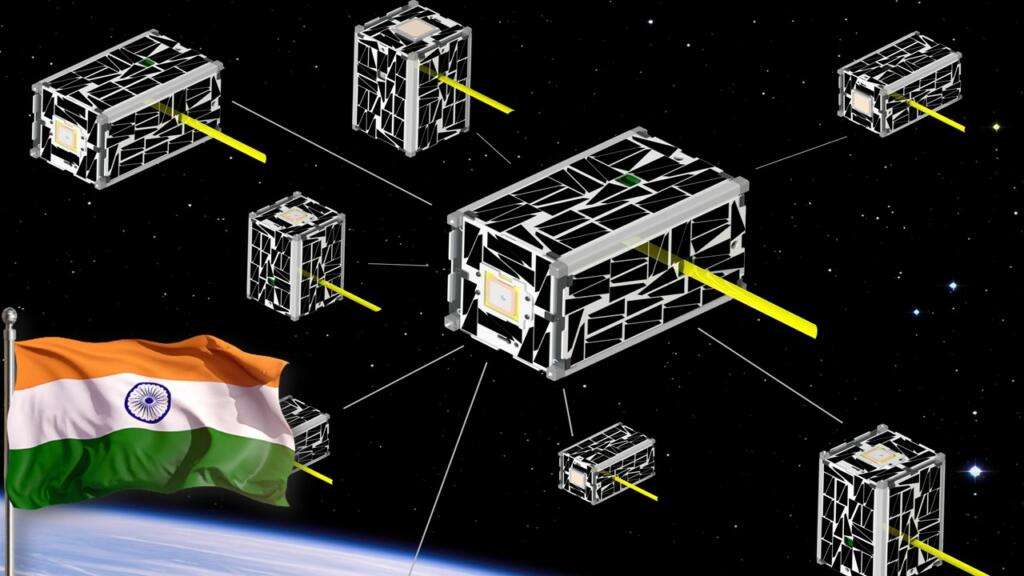Swarm satellites Intelligence: Exact information and proper planning are the keys to winning any war. Upgrading military capabilities is necessary, but a robust information architecture is a must. This has always required intelligence agencies and human resources. But the time has changed. Now the developments are happening at a faster rate with ever-evolving scenarios. In this faster world, whoever gets information first gets a longer window to work things out. In that case, there is a staunch need for strong satellite intelligence.
India to develop swarm satellites
In a recent report, Indian companies in the public and private space sectors are investigating the possibility of collaborating on the creation of a new generation of low-earth orbit satellites (LEO). These satellites will consist of swarms of smaller satellites that will have the ability to communicate with each other. The satellite will collect a variety of data, including visuals, radars, and radio frequency (RF) information.
Swarm satellites have wide usage that ranges from weather forecasting to bolstering security architecture. The initiative of the government of India to modernise the security architecture through infrastructure boosts and technological advancement has inspired many companies to take the necessary steps. In line with that, the development of swarm satellites will prove to be a milestone for Indian intelligence.
Also read: Satellite developed by ISRO is going to be China and Pak’s worst nightmare
Equivalent to the developed world
Currently, countries like the US, among others, are developing such swarm satellites for defence and security purposes by giving them a “hive mind.” It means the working of many satellites in a unified manner, like a single entity. India, like other developing countries, has mostly accommodated technologies after the developed countries made them successful. But now India is taking initiatives towards new and emerging technologies. And swarm satellites are exemplifying that.
Towards digitally fortified borders
The satellites will be primarily focused on border areas and will utilise machine learning algorithms to identify high-value observation targets. India shares land borders with many countries, out of which Pakistan and China are the most crucial, posing a potential threat to India.
The infiltration at the Pakistan border, with the help of tunnels and other permeable border points, can be easily sensed and worked upon. Similarly, the infrastructural development along LAC too needs to be under watch. As it is well known, borders with China are at high altitudes with adverse weather conditions.
The bumpy terrain and unaccessible points at the border make it difficult to maintain strong vigilance. While India’s infrastructure boost is growing in an unprecedented way, the swarm satellite will augment this whole security architecture.
Also read: Rafale, Anti-Satellite Weapon and much more, 2019 a golden year for India’s defence preparedness
Will send multiple angles and only crucial images
Swarm satellites will coordinate their attitude and timing to obtain various viewpoints of the same target. As of now, satellite images show an image of any place that has some security implications. But most of the time, these images are too vague, and nothing much comes out of them except the initial information.
It always raises the necessity of more real-time information with multiple-angle images so that a complete analysis can be done in a short period of time. Apart from that, traditional space-based sensors currently necessitate the transfer of data to Earth for processing and distribution. Routine information is sent to the earth, and then the implications of that information are analysed for further usage.
Contrary to that, satellite swarms equipped with collective intelligence will have the capacity to swiftly detect activities of interest and directly communicate with ground-level users, providing spontaneous information. By automatically sensing information of interest, swarms will save time and resources, which are most significant for intelligence. These satellite will possess the ability to detect even slight alterations in the target area and contrast them with images captured a few hours or days earlier.
Also read: ISRO successfully launches earth observation satellite RISAT-2B
Swarm will save time and resources
They will immediately notify any changes that have occurred. This will decrease the amount of time needed to study such changes at ground level and minimise the possibility of ground control overlooking alterations that are taking place at the target spot. These capabilities will be particularly crucial in border areas where intrusions and infrastructure development mostly go unnoticed because of low access.
The development of swarm satellites is definitely a significant step towards a robust intelligence system. The indulgence of private actors alongside public enterprises will strengthen the capabilities of development. Once the swarm satellites are employed to monitor, the intelligence capabilities of India will reach an entirely new level.
Support TFI:
Support us to strengthen the ‘Right’ ideology of cultural nationalism by purchasing the best quality garments from TFI-STORE.COM
